-
 Bitcoin
Bitcoin $115100
-3.07% -
 Ethereum
Ethereum $3649
0.37% -
 XRP
XRP $3.070
-0.95% -
 Tether USDt
Tether USDt $0.0000
-0.06% -
 BNB
BNB $763.2
-0.11% -
 Solana
Solana $177.3
-4.69% -
 USDC
USDC $0.9998
-0.01% -
 Dogecoin
Dogecoin $0.2262
-4.01% -
 TRON
TRON $0.3142
1.79% -
 Cardano
Cardano $0.7908
-1.25% -
 Hyperliquid
Hyperliquid $42.20
-1.13% -
 Stellar
Stellar $0.4137
-2.00% -
 Sui
Sui $3.652
-1.36% -
 Chainlink
Chainlink $17.52
-2.20% -
 Bitcoin Cash
Bitcoin Cash $528.9
5.25% -
 Hedera
Hedera $0.2374
-1.84% -
 Avalanche
Avalanche $23.13
-1.71% -
 Litecoin
Litecoin $111.1
-2.30% -
 UNUS SED LEO
UNUS SED LEO $8.974
-0.31% -
 Shiba Inu
Shiba Inu $0.00001333
-1.46% -
 Toncoin
Toncoin $3.102
-1.04% -
 Ethena USDe
Ethena USDe $1.001
-0.05% -
 Uniswap
Uniswap $10.03
-0.76% -
 Polkadot
Polkadot $3.934
-1.93% -
 Monero
Monero $322.4
1.19% -
 Dai
Dai $1.000
0.01% -
 Bitget Token
Bitget Token $4.459
-2.45% -
 Pepe
Pepe $0.00001205
-4.02% -
 Aave
Aave $288.3
0.36% -
 Cronos
Cronos $0.1291
3.50%
How to optimize EMA in a volatile market? Parameter enlargement or use other indicators?
In volatile crypto markets, optimizing EMA involves adjusting period length and integrating indicators like RSI, Bollinger Bands, and MACD for better trading signals.
May 28, 2025 at 09:08 am
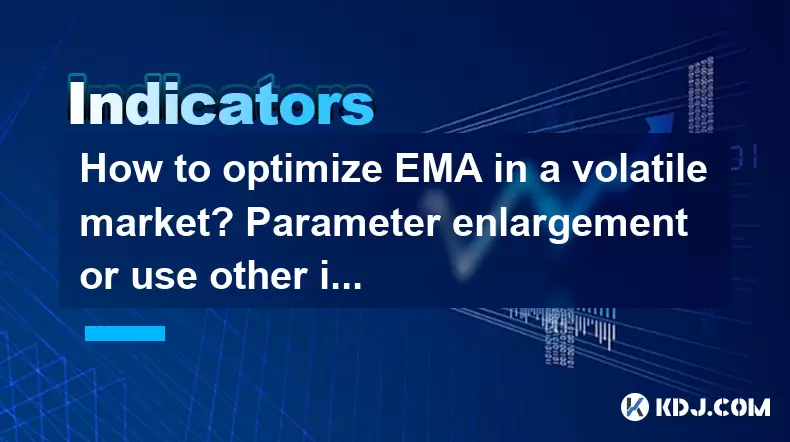
In the cryptocurrency market, the Exponential Moving Average (EMA) is a popular tool for traders looking to navigate the often volatile landscape. The effectiveness of the EMA can be influenced by the choice of parameters and the integration of other indicators. This article explores how to optimize the EMA in a volatile market, considering whether to enlarge parameters or incorporate other indicators.
Understanding EMA and Volatility
The Exponential Moving Average (EMA) is a type of moving average that places a greater weight and significance on the most recent data points. This makes it more responsive to new information, which is particularly useful in volatile markets where prices can change rapidly.
Volatility in the cryptocurrency market refers to the degree of variation of trading prices over time. High volatility means that the price of a cryptocurrency can change dramatically in a short period, which can be both an opportunity and a challenge for traders.
Parameter Enlargement
Adjusting the parameters of the EMA can significantly affect its performance in a volatile market. The primary parameter to consider is the period length.
Shortening the EMA period makes the moving average more sensitive to recent price changes. For example, a 10-day EMA will react more quickly to price movements than a 50-day EMA. In a volatile market, a shorter period can help traders capture rapid price movements, but it may also result in more false signals.
Lengthening the EMA period makes the moving average less sensitive to recent price changes, providing a smoother line that may help filter out market noise. A longer period can be beneficial in highly volatile markets to avoid being whipsawed by short-term fluctuations. However, it may also delay entry and exit signals.
Using Other Indicators Alongside EMA
While adjusting the EMA parameters can be effective, combining the EMA with other indicators can enhance its utility in volatile markets.
Relative Strength Index (RSI): The RSI measures the speed and change of price movements. It can be used to identify overbought or oversold conditions. In a volatile market, the RSI can help confirm EMA signals. For instance, if the EMA indicates a bullish trend and the RSI is below 30, it could signal a strong buying opportunity.
Bollinger Bands: These bands consist of a moving average (often the 20-day simple moving average) and two standard deviation lines plotted above and below it. Bollinger Bands can help traders gauge volatility and potential price breakouts. When the bands widen, it indicates higher volatility, which can be a signal to adjust the EMA parameters.
MACD (Moving Average Convergence Divergence): The MACD is a trend-following momentum indicator that shows the relationship between two moving averages of a security’s price. It can be used to identify trend reversals and momentum. In a volatile market, the MACD can help confirm or refute EMA signals, providing a more robust trading strategy.
Practical Application of EMA and Other Indicators
To effectively use the EMA and other indicators in a volatile market, traders need to follow a systematic approach:
Select the EMA period: Depending on the desired sensitivity, choose a shorter period (e.g., 10-day EMA) for quick reactions or a longer period (e.g., 50-day EMA) for smoother signals.
Integrate complementary indicators: Use the RSI to identify overbought/oversold conditions, Bollinger Bands to gauge volatility, and MACD to confirm trends.
Monitor and adjust: Continuously monitor the market and adjust the EMA period and other indicators as needed. For instance, if volatility increases significantly, consider lengthening the EMA period to filter out noise.
Case Study: Applying EMA in a Volatile Market
Consider a scenario where Bitcoin is experiencing high volatility. A trader decides to use a combination of a 20-day EMA, RSI, and Bollinger Bands to navigate the market.
- Step 1: Set up the 20-day EMA on the Bitcoin chart to track the trend.
- Step 2: Add the RSI with a 14-day period to identify overbought (above 70) and oversold (below 30) conditions.
- Step 3: Plot Bollinger Bands with a 20-day moving average and two standard deviations to monitor volatility.
- Step 4: Analyze the signals. If the 20-day EMA is trending upward and the RSI is below 30, it may indicate a buying opportunity. If the Bollinger Bands widen significantly, it suggests increased volatility, which might require adjusting the EMA period.
Combining EMA with Trading Strategies
Different trading strategies can be employed to optimize the use of EMA in volatile markets. Here are a few examples:
Trend Following: Use a longer EMA period (e.g., 50-day) to identify the overall trend. Enter trades in the direction of the trend when shorter-term EMAs (e.g., 10-day) cross above or below the longer-term EMA.
Mean Reversion: Use a shorter EMA period (e.g., 10-day) to identify potential reversions to the mean. When the price deviates significantly from the EMA, it may indicate a potential reversal point.
Breakout Trading: Combine the EMA with Bollinger Bands to identify potential breakouts. When the price moves outside the Bollinger Bands and the EMA confirms the direction, it may signal a strong breakout trade.
Backtesting and Optimization
To ensure the effectiveness of the EMA and other indicators in a volatile market, backtesting and optimization are crucial. Traders should:
- Backtest different EMA periods to find the optimal setting for their specific market conditions.
- Test various combinations of indicators to determine which ones work best together.
- Optimize the strategy based on historical data, adjusting parameters and indicator settings to improve performance.
Frequently Asked Questions
Q1: Can EMA be used effectively in all types of volatile markets?
A1: While the EMA can be a valuable tool in volatile markets, its effectiveness depends on the specific market conditions and the trader's strategy. In highly volatile markets with frequent price swings, a shorter EMA period may be more suitable, whereas in moderately volatile markets, a longer period might be more effective.
Q2: How often should I adjust the EMA period in a volatile market?
A2: The frequency of adjusting the EMA period depends on the level of volatility and the trader's strategy. In extremely volatile markets, adjustments might be needed more frequently, possibly daily or even intraday. In less volatile conditions, weekly or monthly adjustments may suffice.
Q3: Are there any risks associated with using multiple indicators alongside the EMA?
A3: Yes, using multiple indicators can lead to overcomplication and conflicting signals. It's important to understand the strengths and weaknesses of each indicator and ensure they complement rather than contradict each other. Over-reliance on multiple indicators can also lead to analysis paralysis, where a trader becomes hesitant to act due to too many signals.
Q4: How can I determine if my EMA strategy is performing well in a volatile market?
A4: To assess the performance of an EMA strategy in a volatile market, track key metrics such as win rate, average profit/loss per trade, and drawdown. Additionally, compare the strategy's performance against a benchmark, such as a buy-and-hold approach, to determine if it is adding value. Regularly review and adjust the strategy based on these metrics to optimize performance.
Disclaimer:info@kdj.com
The information provided is not trading advice. kdj.com does not assume any responsibility for any investments made based on the information provided in this article. Cryptocurrencies are highly volatile and it is highly recommended that you invest with caution after thorough research!
If you believe that the content used on this website infringes your copyright, please contact us immediately (info@kdj.com) and we will delete it promptly.
- Ether ETFs Surge, Bitcoin Wobbles: Is an ETH Breakout Imminent?
- 2025-07-25 16:50:12
- Bitcoin, Symmetrical Triangles, and the Great Unknown: What's Next?
- 2025-07-25 16:30:12
- EigenLayer's Multi-Chain AVS Ecosystem: A New Era for Web3?
- 2025-07-25 16:30:12
- StablecoinX's $360 Million Bet: Forging the Ethena Treasury
- 2025-07-25 15:30:12
- Ethereum's Wild Ride: Navigating Volatility and New Risks
- 2025-07-25 15:10:12
- Ethereum Inflows Outpace Bitcoin Outflows: Institutional Adoption Heats Up
- 2025-07-25 15:30:12
Related knowledge

What does it mean that the KDJ indicator forms a double bottom at a low level?
Jul 25,2025 at 05:08pm
Understanding the KDJ Indicator in Cryptocurrency TradingThe KDJ indicator is a momentum oscillator widely used in cryptocurrency trading to identify ...
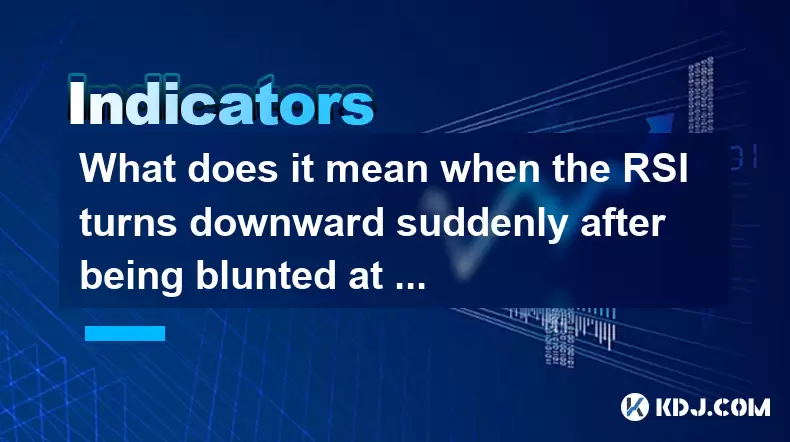
What does it mean when the RSI turns downward suddenly after being blunted at a high level?
Jul 25,2025 at 04:00pm
Understanding the RSI and Its Role in Technical AnalysisThe Relative Strength Index (RSI) is a momentum oscillator that measures the speed and change ...
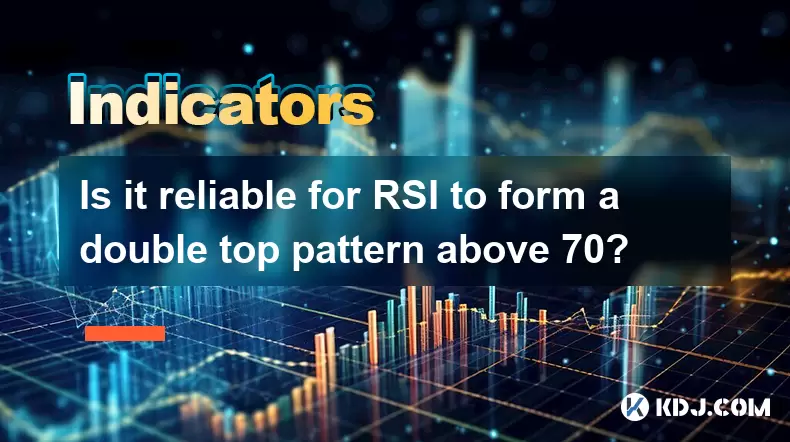
Is it reliable for RSI to form a double top pattern above 70?
Jul 25,2025 at 04:49pm
Understanding the RSI Indicator and Its Role in Technical AnalysisThe Relative Strength Index (RSI) is a momentum oscillator that measures the speed a...
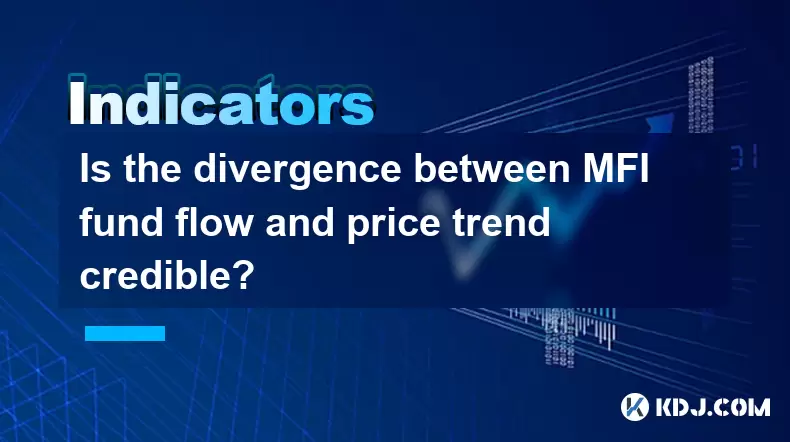
Is the divergence between MFI fund flow and price trend credible?
Jul 25,2025 at 12:01pm
Understanding MFI and Fund Flow in Cryptocurrency MarketsThe Money Flow Index (MFI) is a technical oscillator that combines price and volume to assess...
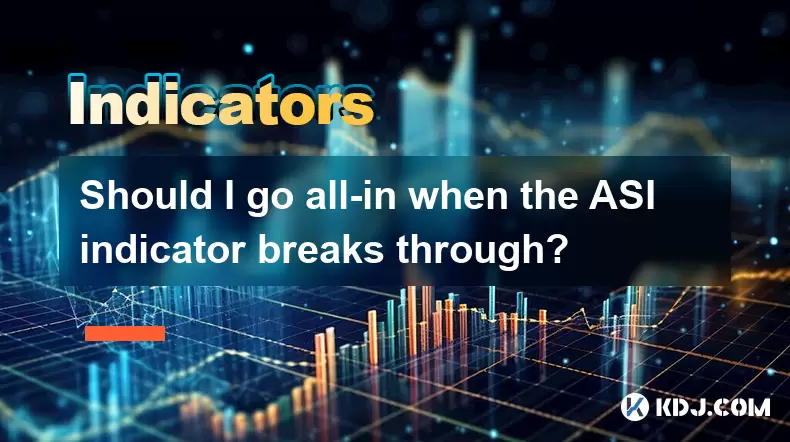
Should I go all-in when the ASI indicator breaks through?
Jul 25,2025 at 01:56pm
Understanding the ASI Indicator and Its SignificanceThe Accumulation Swing Index (ASI) is a technical analysis tool developed by Welles Wilder, the sa...

Should I go all in when DIF crosses DEA?
Jul 25,2025 at 12:42am
Understanding DIF and DEA in MACD AnalysisWhen traders analyze DIF and DEA in the context of the Moving Average Convergence Divergence (MACD) indicato...

What does it mean that the KDJ indicator forms a double bottom at a low level?
Jul 25,2025 at 05:08pm
Understanding the KDJ Indicator in Cryptocurrency TradingThe KDJ indicator is a momentum oscillator widely used in cryptocurrency trading to identify ...

What does it mean when the RSI turns downward suddenly after being blunted at a high level?
Jul 25,2025 at 04:00pm
Understanding the RSI and Its Role in Technical AnalysisThe Relative Strength Index (RSI) is a momentum oscillator that measures the speed and change ...

Is it reliable for RSI to form a double top pattern above 70?
Jul 25,2025 at 04:49pm
Understanding the RSI Indicator and Its Role in Technical AnalysisThe Relative Strength Index (RSI) is a momentum oscillator that measures the speed a...

Is the divergence between MFI fund flow and price trend credible?
Jul 25,2025 at 12:01pm
Understanding MFI and Fund Flow in Cryptocurrency MarketsThe Money Flow Index (MFI) is a technical oscillator that combines price and volume to assess...

Should I go all-in when the ASI indicator breaks through?
Jul 25,2025 at 01:56pm
Understanding the ASI Indicator and Its SignificanceThe Accumulation Swing Index (ASI) is a technical analysis tool developed by Welles Wilder, the sa...

Should I go all in when DIF crosses DEA?
Jul 25,2025 at 12:42am
Understanding DIF and DEA in MACD AnalysisWhen traders analyze DIF and DEA in the context of the Moving Average Convergence Divergence (MACD) indicato...
See all articles

























































































